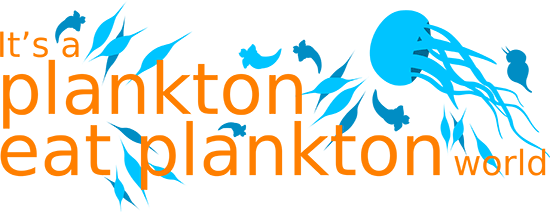
Illustrated by: Sabine Deviche and James Baxter
show/hide words to know
 Inside a drop of water that you might collect from a stream, river, lake or ocean are tiny organisms. These tiny and sometimes not so small living things are called plankton.
Inside a drop of water that you might collect from a stream, river, lake or ocean are tiny organisms. These tiny and sometimes not so small living things are called plankton.
What role do plankton play in aquatic food webs? What do plankton eat, and what uses plankton as a food source? As you learned in Invisible Watery World,there are two different types of plankton, phytoplankton and zooplankton.
All other life in the ocean needs phytoplankton to survive. Phytoplankton get their energy directly from the sun using photosynthesis, just like plants. Zooplankton then feed on phytoplankton, and are then eaten by larger zooplankton, fish, larger fish, and so on. Plankton are at the base of a complex aquatic food web.
During this activity you will learn how to create your own food web. You will also analyze the feeding relationships between marine organisms and describe plankton’s importance to the ecosystem.
What You Need
- Marine Food Web worksheets (Download PDF)
- Colored Pencils
- Scissors
- Yarn
- Glue
Before You Begin
- Print out the Marine Food Web worksheets.
- Color and cut out the marine organisms on the “Marine Organisms” page.
- Read “Invisible Watery World” and look at the “What do I eat?” table.
Now it is time to begin building your Marine Food Web!
Procedure
 Step 1: You will use the yarn to show how organisms are connected in your food web. Start with the phytoplankton that you colored and cut out. You will glue the phytoplankton to your “Marine Food Web” worksheet. The sun provides phytoplankton the energy needed to survive. Represent the relationship between the sun and phytoplankton with a piece of string.
Step 1: You will use the yarn to show how organisms are connected in your food web. Start with the phytoplankton that you colored and cut out. You will glue the phytoplankton to your “Marine Food Web” worksheet. The sun provides phytoplankton the energy needed to survive. Represent the relationship between the sun and phytoplankton with a piece of string.
Step 2: Draw an arrow to show the direction the energy moves. Arrows represent energy flow from one organism to the next so make sure that your arrow faces the right direction. The sun gives energy to phytoplankton, so the arrow faces phytoplankton, as shown.
 Step 3: Which organisms consume phytoplankton to gain energy for survival? Zooplankton. Just like in steps 1 and 2, you will represent this relationship by connecting the phytoplankton and zooplankton with a piece of string, and draw an arrow to show the energy flow. Make sure your arrow is pointing in the right direction.
Step 3: Which organisms consume phytoplankton to gain energy for survival? Zooplankton. Just like in steps 1 and 2, you will represent this relationship by connecting the phytoplankton and zooplankton with a piece of string, and draw an arrow to show the energy flow. Make sure your arrow is pointing in the right direction.
Step 4: Keep adding organisms, using the “What do I eat?” table to figure out what each organism eats. Add organisms until you reach one that is not consumed by any other organism. That organism is called an Apex Predator.
Step 5: You will have some cut-out organisms that are not part of your food web. That’s okay! Start again with the sun and add on each organism just like you did before. Keep adding arrows to show which way the energy flows. When you run out of organisms, you are done.
The end result will be a Marine Food Web!
Colleen Miks received her Bachelors of Science in Fisheries Biology from Humboldt State University. She received her Masters of Education from Plymouth State University and teaches Earth and Space Science at Sossaman Middle School in Gilbert Arizona.
This Ask A Biologist activity was funded by NSF Grant Award number 0752592 and 1030345.
View Citation

This activity has a companion article on Plankton. Discover an Invisible Watery World in water full of creatures too small to be seen!
Be Part of
Ask A Biologist
By volunteering, or simply sending us feedback on the site. Scientists, teachers, writers, illustrators, and translators are all important to the program. If you are interested in helping with the website we have a Volunteers page to get the process started.







